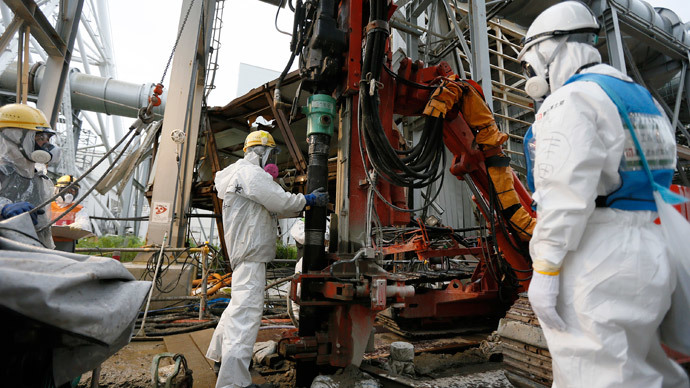Japan’s nuclear watchdog says the radioactive water that has accumulated at the battered Fukushima Daiichi nuclear power plant must be decontaminated and dumped into the ocean, local media reported. The news has sparked concern from local fisherman.
READ MORE: Fukushima radiation detected 100 miles off California coast
“We have to dispose of the water,” Shunichi Tanaka,
chairman of the Nuclear Regulation Authority (NRA), told a media
conference after visiting the crippled nuclear power plant on
Friday, Asahi Shimbun reported.
The NRA chief was referring to the contaminated water stored in
tanks on the premises of the crippled Fukushima Daiichi power
plant. He added that the water – which is tainted with
radioactive material – poses a risk to the safety of the
decommissioning work.
Tanaka has previously stated that the radioactive water at the
site needs to be decontaminated so it falls under safety
standards – and then it must be released into the sea.
This is aimed at battling growing amounts of toxic water
accumulating in the plant’s buildings, and at reducing the volume
of groundwater that is flowing through the premises and becoming
contaminated.
“We also have to obtain the consent of local residents in
carrying out the work, so we can somehow mitigate [the increase
in tainted water],” he added on Friday. “While [the
idea] may upset people, we must do our utmost to satisfy
residents of Fukushima.”
Local fishermen have expressed concern over the contaminated water and other issues linked with water management at the Fukushima plant.
READ MORE: ‘TEPCO covered up the truth about Fukushima disaster’
Fukushima Prefectural Federation of Fisheries Co-operative
Associations submitted a petition that calls on the government
and Tokyo Electric Company (TEPCO) – the nuclear plant's operator
– to make sure that the water released into the Pacific is safe
and below the required radiation levels.
Plans to dump the water from the crippled nuclear plant into the
ocean after removing the most dangerous radioactive elements were
voiced as early as March. However, TEPCO’s initial efforts
failed and the plan was indefinitely suspended after malfunctions crippled the
water purification process and recontaminated thousands of tons
of already cleaned liquid.
Some 400 tons of untainted groundwater are believed to be seeping
into the buildings of the Fukushima plant on a daily basis. It is
then mixing with the toxic water generated in the process of
cooling the crippled reactors. TEPCO collects the radioactive
groundwater and stores it at the site of the plant. However,
storing the groundwater becomes more difficult each day, as the
water quantity continues to increase.
Following the earthquake and tsunami on March 11, 2011, three
reactors at the plant suffered nuclear meltdowns, causing a
radioactive fallout. The catastrophe was the world’s worst
nuclear disaster since Chernobyl in 1986. TEPCO is engaged in a
cleanup process at the site, which has been dogged by delays and
setbacks. In January, the company started erecting a
controversial underground frozen wall which is planned to stop
radioactive water from seeping into the sea.

